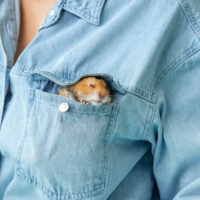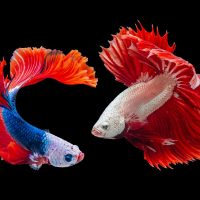Why Is My Goldfish Fat? Could My Fish Be Pregnant..
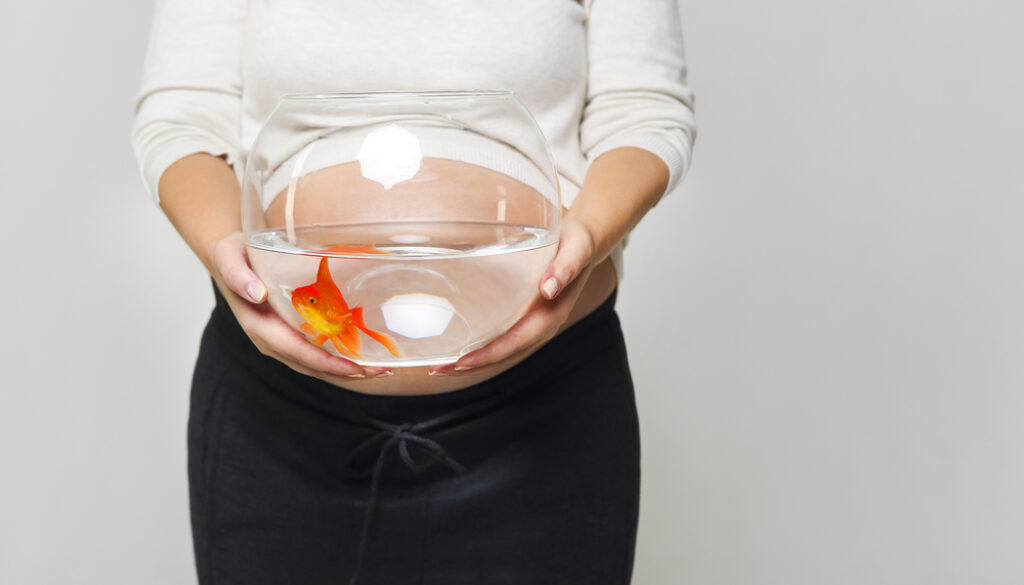
It’s like any other day, you are sitting at your desk, staring into oblivion and you ask yourself a very interesting question, ‘Why is my goldfish fat?‘
Of course, there are many reasons why your workplace fish is fat and you may not be the root cause of it.
Is my goldfish pregnant?
Many people buy pregnant goldfish from the pet shop without realising it. You may end up with more goldfish than you bargained for, but only if you have some male goldfish based in the same tank. Once eggs have been fertilised, it takes around 4 days for the eggs to hatch.
One way to test if your goldfish is pregnant is to reach your hand in the water to pick up your fish and if you notice a few eggs come out as she flaps around in your hand… you know the answer.
Why is my goldfish being chased?
Chasing happens when the females release pheromones into the water. This sends signals to male goldfish that it’s breeding time.
Males will chase the female from behind while poking her stomach to try and release some eggs for fertilisation. During this time, one side of the goldfish may seem bigger than the other side. This is often due to the eggs filling only one side of her body.
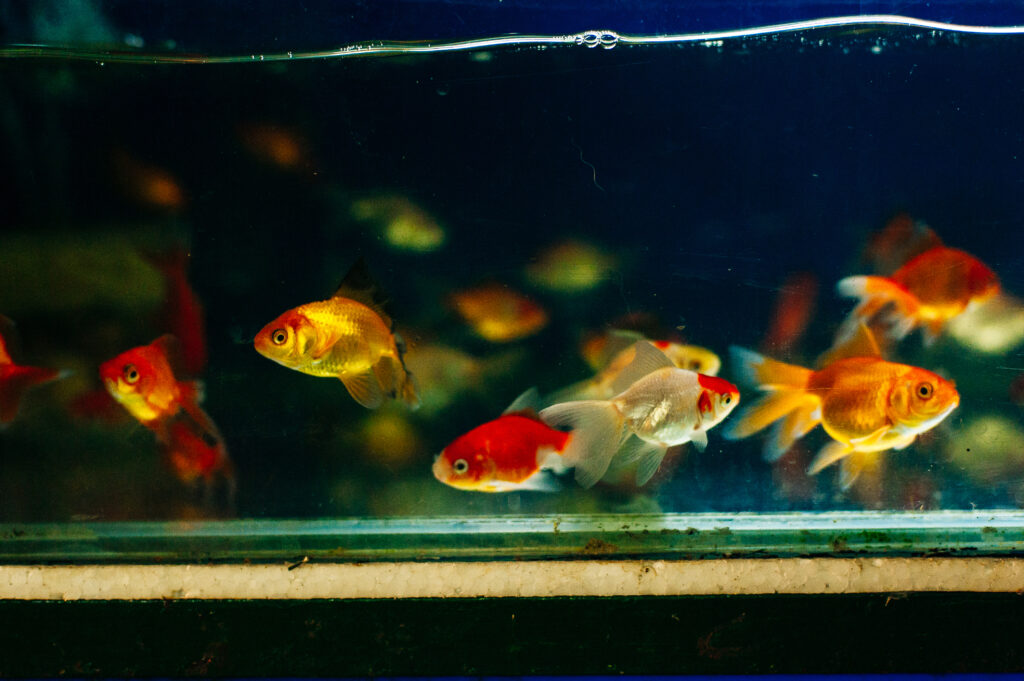
Has my Goldfish been Overfed?
Goldfish aren’t fussy eaters. They are happy to eat most foods. This may be why your goldfish is fat. Just don’t give them every food, because foods such as bread could get caught up inside their intestines, resulting in constipation and even death.
Flakes have been marketed extremely well. They may be the most practical, but are they best for your fish? Types of goldfish food include;
- Flakes
- Sinking pellets
- Pellets
- Live foods
- Freeze dried live food
- Fruit and Vegetables
Flakes
Flakes are probably the most common type of goldfish food and usually most affordable, which is why people tend to have a preference for them.
The problem with using flakes, which most people don’t realise – is that fish don’t always eat them fast enough, resulting in water pollution. Because of how light flakes are, they tend to flow into the filter. Over time, flakes can also lose some nutritional value after the tub is opened and exposed to air. For these reasons alone, you may start to think twice about giving flakes to your fish.
Pellets/Granules
Pellets/granules are a common type of goldfish food that can be found in almost all pet shops. They are also very practical for the office environment as they don’t smell or stick to anything as much, compared to the alternatives.
Similar to the flakes, most pellets/granules will float on the water. But because the pellets being denser than flakes, they are easier to remove and take longer to disintegrate and pollute the water in the tank. Uneaten food should always be removed.

Live foods
In the wild, goldfish eat plants, insects and even smaller fish. While you may find it challenging to match their natural diet, you should be able to get close and find similar food to what they would eat naturally. Goldfish enjoy many live foods, a few you can purchase from your local pet shop. Some of the tasty treats that goldfish love, include; Brine/Ghost shrimp, Mealworms, Daphnia and Aquarium Snails.
Live foods offer a great source of protein for your goldfish. The process of catching and eating them is also closer to what your goldfish would do in the wild. It all depends on your tank/pond setup and how you want to bring up your fish.
One issue with keeping live food is that you risk introducing disease and infections to your tank. So extra care in buying and storing needs to be considered.
Freeze dried foods
Like live foods, freeze-dried foods offer lots of protein, but without the risk of disease. I recommend always picking this option of food over the live variety.

Fruit and Vegetables
Surprisingly, Goldfish can eat many types of vegetables such as peas, lettuce, broccoli, cauliflower and even apples and grapes. Feeding your fish fruit and vegetables may reduce goldfish fat allowing the fish to feel more comfortable at work!
Fruit and vegetables are important components of your goldfish’s diet as they are a great source of vitamins and minerals. Fruit and vegetables also provide an excellent source of dietary fibre, which can help prevent constipation in goldfish.

How much should I feed my goldfish?
Adding too much food can cause your goldfish to eat too much, which leads to blocked organs. If you spot a trail of poop following your goldfish around, It’s a sign that your fish needs to go on a fruit and vegetable diet.
Slowly add tiny pinches of food to your tank. Only give an amount of food that the fish can eat within 1 minute. Never pour food directly from the tub into the tank.
We keep real plants in our fish tanks such as Java fern, Anubias and Crypts. These plants help supplement the small amounts of flakes or pellets that we give them. Having plants in the tank makes it hard to under-feed your goldfish, but it’s very easy to over-feed them. So you need to be careful!
Overfeeding can be very fatal for Goldfish as they don’t have stomachs, so they never get “full up.” This means that goldfish will eat and eat for as long as the food keeps coming.
Water temperature is also something to consider. Shockingly, goldfish each more in warmer water. when the water temperature is lower, the goldfish eats less, this is because the metabolism slows down.
When feeding your fish keep to a feeding schedule. This will help your goldfish develop a regular pattern and aid their digestive cycle, which will help prevent illness and diseases.

How long can goldfish live without food?
If you’re going on holiday, it’s worth asking your colleague to fish sit, just make sure they know how to look after goldfish properly.
As a last resort, there are products in the market that can automatically feed your fish, they will release set amounts of food at regular intervals. But be careful, technology can break. The last thing you want is a feeder to release too much food or run out of batteries and not release any… To test this method out first.
If you are going away for just a weekend, the pyramid feeders may work as an alternative method, they sit inside your tank for 3 days and slowly dissolve, while releasing food in the process.
Goldfish Feeding blocks are also an option. These blocks of food sit in the water for your fish to nibble on. However, when you return from holiday, the water may be a little cloudy.
Goldfish can surprisingly live a long time without food. If I was going on holiday for two weeks or less, I would consider leaving my goldfish with just the Java fern, Anubias and Crypts plants in the tank.
Does your goldfish look swollen?
If your goldfish looks swollen, it may have Dropsy. An extremely serious and often fatal condition affecting goldfish. If you notice your goldfish looking overall fat then the problem is probably dropsy. Here is some information on what Dropsy is and steps on how to cure it.
If your fish does not have Dropsy… Why is my goldfish fat? It may just be constipated. Add some vegetables to the tank for some fibre. After a week you should hopefully see some results.
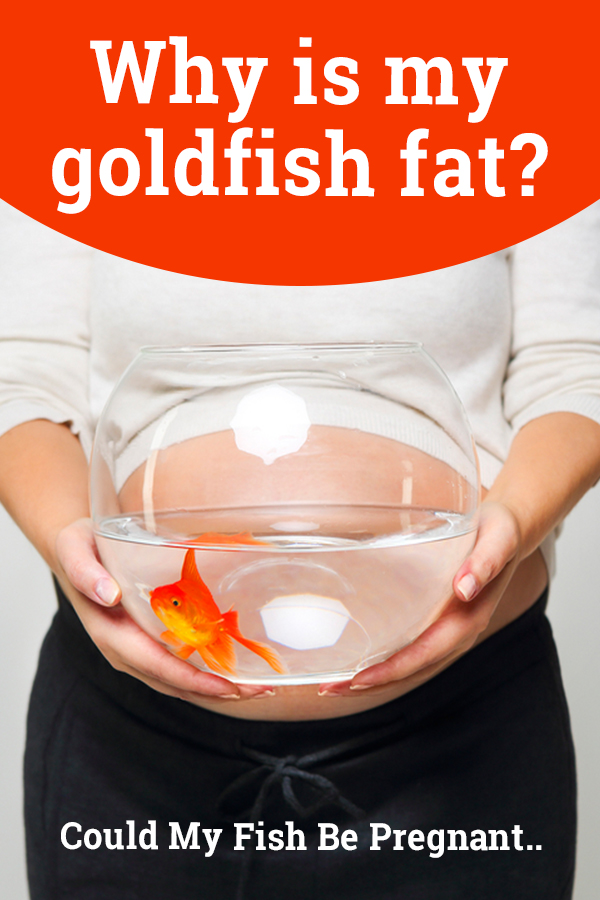
Most problems with Goldfish relate to overfeeding. If you look after your goldfish well, they can live up to 10 years or longer.
